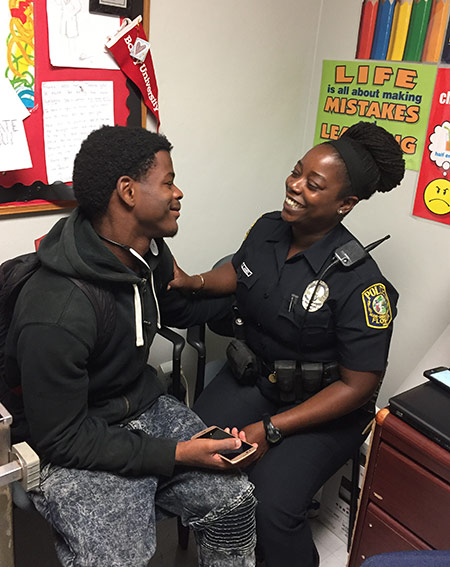Contact Us
To provide feedback on the Community Policing Dispatch, e-mail the editorial board at CPDispatch@usdoj.gov.
To obtain details on COPS Office programs, publications, and resources, contact the COPS Office Response Center at 800-421-6770 or AskCopsRC@usdoj.gov

U.S. Department of Justice
Office of Community Oriented Policing Services
Washington, DC 20530
Cops in schools: It’s a contentious issue in contemporary American society. School administrators and law-enforcement partners are concerned about it. But other partners—including teachers, counselors, other school staff members, and parents—are also thinking about the best ways to improve school safety. Some people feel that we desperately need to place a sworn, local law-enforcement officer in schools, in addition to regular school security officers. Others are wary that such appointments lead to increases in arrests, with a disproportionate impact on students of color and students with disabilities. If we have law-enforcement officers in our schools, how do we do it right?
Having worked at the nexus of education and law enforcement for more than 30 years by training School Resource Officers (SROs) in crime, drug, violence, and bullying prevention; and helping school administrators to develop effective policies and practices involving the use of law enforcement officers in schools, I have formed some observations and guiding questions that may help school and community leaders answer that question. Based on my experience working with some excellent SROs who really understand crime prevention and who do not want to arrest students, I believe police officers can be an important addition to our schools. From my experience training many SROs around the country, I know that we can establish the right climate of safety that is conducive to learning—if we employ well-trained officers who genuinely like working with students.
As in any other field, we should be using evidence-based programs and approaches when it comes to school-based law enforcement. The problem is that there isn’t a whole lot of rigorous research to guide us. The federal National Institute of Justice recently sponsored a number of studies that will inform our practice, but that research is ongoing involving studies over multiple years. However, we have had SROs in schools since the 1950s and have learned important things about how to do it right. Here’s what we know:
- We must clearly define roles. School Resource Officers perform many functions, including educator, mentor/informal counselor, and law enforcement officer. These functions vary by school environment and community needs. But one role the SRO should not play is that of enforcing school discipline. An SRO is sworn to uphold civil law, not enforce school rules. Communities should carefully consider how the role of the SRO differs from and complements that of the school security officer.
- We need to make sure that we select the most appropriate officers to work in our schools. Recall that SROs work for the local law-enforcement agency from which they are assigned. They are partners with the school district, not the administrators’ personal 9-1-1 officers.
We should therefore pay close attention to candidates’ motivations to assume this role. Are they volunteering for the job or have they been assigned to it? Do they really want to help students and keep them out of trouble?
School and community members’ involvement in the process of interviewing and selecting the SROs can further clarify their roles and expectations.
- We must make sure the SROs are adequately prepared to do their job. Anyone who works in schools should receive special training to better understand today’s young people and the problems they face. School Resource Officers’ training must be thorough, up-to-date, and go beyond standard training as a law-enforcement officer.
In addition to having basic SRO training, these officers should have access to specialized training in accordance with the specific expectations of the local law-enforcement/school/community partnership. That might include training in adolescent brain development, de-escalating threatening situations, mental-health awareness and how to make referrals, understanding special needs, or more. If the SRO is trained with members of the school community, everyone can be on the same page.
- We should define policy for a stronger partnership. What is the policy that guides the partnership between school districts and law enforcement? An official memorandum of understanding (MOU) can clarify the duties and responsibilities of both the law enforcement and school partners so that the entire community understands the role of the SROs. This policy should include a clear statement that enforcing school discipline is not part of their job.
- We must engage community partners. Keeping schools safe is the responsibility of more than just the education and law-enforcement partners. School/law-enforcement partnerships should identify and team up with other community partners that care about safe schools. For example, local mental-health providers may be able to offer supports to help students and their families when needed.

Photo Courtesy of the Miami-Dade Schools Police Department
The choice about whether to have law-enforcement officers in schools is an important local decision that should be weighed by educators, law enforcement, parents, and other community stakeholders. Those collaborators should carefully consider these lessons to guide them in the process. In doing so, local communities can give our students the supports they need to stay in school—and out of the criminal-justice system.
By John Rosiak
This article was also featured in Education Week
JOHN ROSIAK is an educator, trainer, and facilitator who has supported school/law-enforcement partnerships around the country since the 1980s. He is the founder and principal of Prevention Partnerships, www.rosiakassociates.com which provides training and technical assistance support to help school, law enforcement, mental health, and juvenile justice partners to break down silos to develop effective collaborative efforts for safer and healthier communities.
Subscribe to Email Updates
To sign up for monthly updates or to access your subscriber preferences, please enter your email address in the Subscribe box.






